Pemex produced 76.8 million barrels per day (Mbd) of ethane in 2019, a year-on-year drop of 9.4 percent.
This decrease was the result of less recovery in plants.
In turn, Pemex’s ethane sales stood at 51.5 Mbd, with an increase of 5.3% compared to the previous year.
Since December 2019, Pemex TRI increased its ethane import capacity with the implementation of the vaporization process at the Pajaritos Petrochemical Complex.
This will allow increasing capacity in the ethane-ethylene chain.
According to the company, it is important to highlight that the implementation work is carried out with Pemex TRI human capital, using its own equipment and materials with a minimal investment.
As a consequence of the shortage of ethane, the company has favored the production of products with greater profitability and competitiveness in the market. The production of ethylene and derivatives was 1 million 610,800 tons, 12% lower than the previous year.
Ethane
The elaboration of petrochemicals in the National Refining System includes propylene, sulfur, carbon dioxide and isopropanol.
As of July 2019, Pemex Ethylene merged with Pemex Transformación Industrial, thus integrating the production of ethylene, ethylene oxide, polyethylenes, ethylene glycols, carbon dioxide, oxygen, nitrogen, pyrolysis liquids and propylene.

The main use of ethane is the production of ethene (ethylene) by steam cracking. When diluted with steam and briefly heated to very high temperatures (900 ° C or higher), heavy hydrocarbons break down into lighter hydrocarbons, and saturated hydrocarbons become unsaturated.
Ethane is favored for ethene production because ethane steam cracking is quite selective for ethene, while steam cracking of heavier hydrocarbons produces a product mixture that is poorer in ethene and richer in alkenes (olefins). heavier, such as propene (propylene) and butadiene, and in aromatic hydrocarbons.

